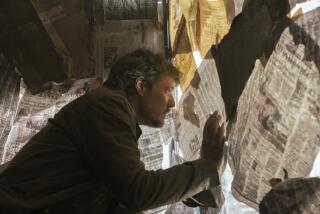Can you believe what time it is?
- Share via
THIS is the end of the story you’re reading. It is also the beginning. And yes, that’s confusing, because you’re expecting this article to unfold in a certain way, following certain norms of language, construction and time.
Sorry.
This paragraph was written after the ones that follow, the last and first paragraphs were written simultaneously a day before these words were put down, and the entire article was finished days ago. If you were to try to read this in the “real time” in which it was written you’d quickly give up, lost in the disorder of still coalescing thoughts. You may even give up now, deciding there isn’t enough structure for communication to work.
Hang in there. Because this is where the art comes into play, whether in novels and poems or movies, theater and television dramas (and even newspaper articles). While warping time has been a creative constant since the days of H.G. Wells, the concept has found fresh life in a recent cluster of novels, television shows and movies -- some debuting this fall -- built around getting us to suspend our conventional concepts of time.
Many of the projects are rooted in the science fiction and fantasy realms. The futuristic movie “Children of Men,” based on the P.D. James novel and opening this winter, uses the standard time skip to imagine the world dissolving into despair after humans are suddenly unable to reproduce. And Darren Aronofsky’s “The Fountain,” set for an October release, follows Thomas (Hugh Jackman) on a thousand-year quest for the fountain of youth in a mix of science fiction, fantasy and traditional drama.
On television, the critically lauded “Life on Mars,” about a modern-day detective suddenly working in the 1970s, began airing on BBC America this winter (an American version is in the works).
“Near history intrigues me greatly,” said Matthew Graham, one of the show’s British creators. “It’s all well and good jumping back to ancient Rome or eavesdropping on the Boston Tea Party, but what would that really tell us about who we are?”
Sending the character Sam Tyler back to a time that falls within the remembered draws on viewer nostalgia and invokes common cultural touchpoints such as music, clothes and TV shows. “If Sam had jumped back a couple of centuries then anything he experienced would be his experience alone and not ours,” Graham said. And since the world wobbled on after the “nuclear fears and communist invasions” of the 1970s, he said, sending viewers back to that era can be an expression of optimism.
“We want to know that things were worse back then, that we have advanced,” Graham said, “We crave a place where the future is set and secure.... Going back to the early ‘70s means trading down on luxury items but trading up on emotional security.”
For some stories, warping time is key to the suspension of disbelief. Setting “Children of Men” in the present or past, for example, asks for too much of a leap, because our real world of robust procreation makes it harder to buy into the movie’s premise that we’ve reached the end of the biological line. But setting the story in the future makes it easier to ask “What if?” .
For author and critic Wendy Lesser, editor of the Threepenny Review literary magazine, the best manipulations of time are the ones you don’t see. “If it jumps out at you, then it is disturbing,” Lesser said. “You begin to think that’s the point of the story.”
Writers rarely play well with time, she said, “except for science fiction, which warps time on purpose and is supposed to be noticed,” whereas filmmakers have better success. “In a movie it is purported to be real people standing in front of you, but of course they can’t be,” Lesser said. “There is a suspension of disbelief. With novels, there is no pretense that someone is standing in front of you .... You’re engaged with the imaginative act, and you can give it full credence if the author doesn’t give it tricky things.”
Other writers don’t see it that way, though, as they suspend conventional concepts of time to better explore the depths of character. Audrey Niffenegger, for example, used time like a yo-yo in her 2004 bestselling love story, “The Time Traveler’s Wife.” “I wanted to let the time shift as a way of moving the point of view around,” Niffenegger said. “It’s like if you were to take a marriage and look at it from a cubist point of view and see all the different facets simultaneously .... In any given scene there might be two points of view and multiple time frames.”
Getting readers and viewers to suspend conceptions of time outside of sci-fi invites skepticism, and rejection. But that doesn’t bother Niffenegger. “If they’re going to be grumpy about it and not play,” she said, “forget it, they can go read about Iraq or something.”
For those who pull it off, “in for a penny, in for a pound” applies. Once you get your audience to buy into the concept, you can take them along on just about any flight of fantasy . The risk, though, is having your book ignored.
“Judging by the fact that science fiction doesn’t sell as well as romance, you probably do” lose readers, said Harry Turtledove, a prolific science fiction and alternative history writer. “You’re looking for a reader who thinks this is a fun game to play.”
Turtledove’s most recent novel, “The Grapple,” is the third in a series that imagines the South won the Civil War and seceded. “The Grapple” imagines North and South squaring off on opposite sides during World War II.
The benefit of such a warping of time and history is “looking at contemporary society through a funhouse mirror,” Turtledove said. And the lure for readers is the human impulse to second-guess.
“We all have mistakes in our past, and we all see what we perceive to be the mistakes in the historical past that ought to be remedied, and if they would be, then everything would be so much better,” Turtledove said. “And similar to the lure of just regular historical fiction is looking at events in one time from the perspective of another .... You can use time travel to project your utopia or dystopia through a modern person’s point of view.”
It works even in books and films that aren’t overtly science fiction. Andrew Sean Greer’s 2004 novel, “The Confessions of Max Tivoli,” followed a character who was born old and lived his life in reverse, crossing time with his generational peers -- going in opposite directions -- at age 35. A central element of the story is Tivoli being rebuffed in a “Lolita” moment by the object of his desire, only to win her heart a few years later when she is older and he is younger.
“The fantasy of approaching someone who rejected you as a teenager, appearing as a young stranger to them, is appealing, unless it turns out they might still reject you,” Greer said. “These are real issues, and the warping of time is a way to make them fresh.”
Chucking aside the constraints of conventional time can be freeing and enlightening.
“It is imagination used to gain perspective,” Greer said. “The attraction for a character aging backward, for me, was not a ‘gee whiz’ moment but really the thought that it might shed light on our real experience with time. The experience, for instance, of feeling a different age inside than you appear to other people is one I believe is common to anyone under 18 or over 40.”
As is the experience of deja vu, in itself a sort of time warp, which can be disorienting as you find yourself seemingly reliving moments, even here, at the end of the story you’re reading. It is also the beginning.
More to Read
The complete guide to home viewing
Get Screen Gab for everything about the TV shows and streaming movies everyone’s talking about.
You may occasionally receive promotional content from the Los Angeles Times.







